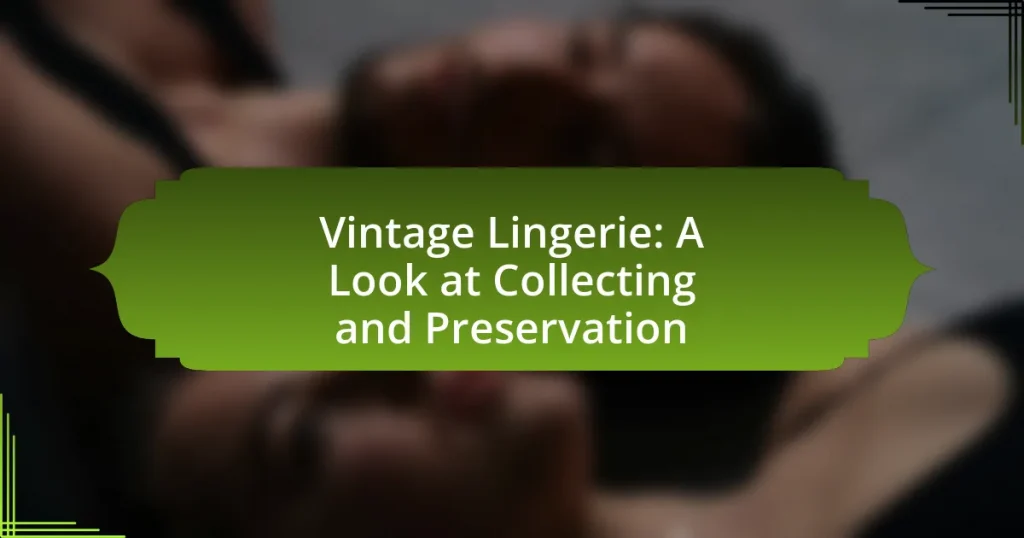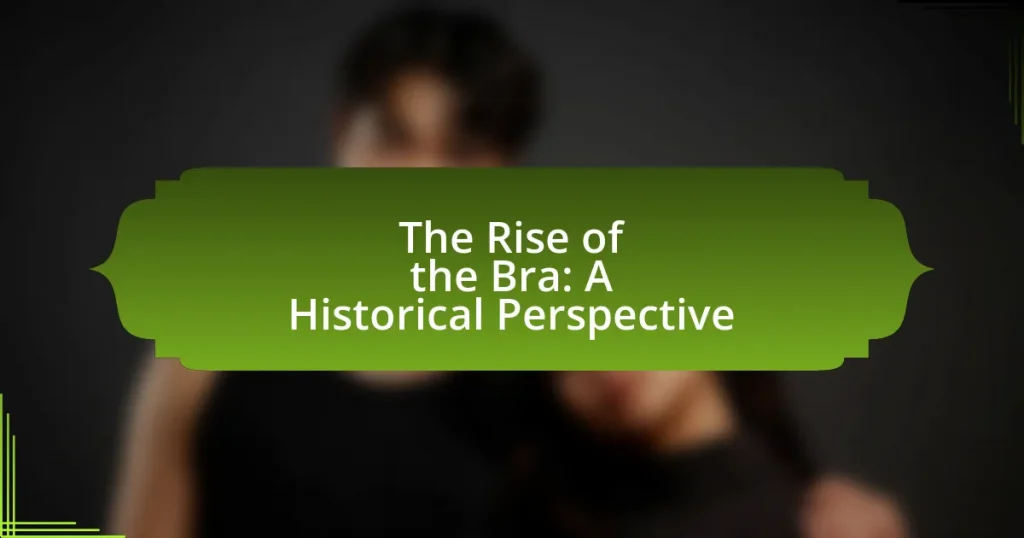Lingerie serves as a significant cultural artifact in popular culture, symbolizing femininity, empowerment, and sexuality. The article explores the evolution of lingerie from a private garment to a public statement, influenced by historical events such as the women’s suffrage movement and the sexual revolution. It examines how societal norms shape lingerie trends, the role of celebrities and media in popularizing these trends, and the impact of burlesque on mainstream perceptions. Additionally, the article highlights current trends in inclusivity and body positivity within the lingerie industry, emphasizing the importance of consumer preferences and social media in shaping marketing strategies.

What is the role of lingerie in popular culture?
Lingerie plays a significant role in popular culture by symbolizing femininity, empowerment, and sexuality. It has evolved from being a private garment to a public statement, often featured in fashion shows, music videos, and advertising campaigns. For instance, the Victoria’s Secret Fashion Show, which ran from 1995 to 2018, showcased lingerie as a form of art and entertainment, influencing perceptions of beauty and desirability. Additionally, lingerie is frequently used in media to convey themes of romance and seduction, reinforcing its cultural significance. This duality of lingerie as both intimate wear and a fashion statement highlights its impact on societal norms regarding body image and sexuality.
How has lingerie evolved in its cultural significance?
Lingerie has evolved from a symbol of modesty and functionality to a representation of empowerment and self-expression in contemporary culture. Historically, lingerie served primarily practical purposes, such as shaping the body and providing support, but over time, it has transformed into a fashion statement that reflects societal attitudes towards femininity and sexuality. In the early 20th century, the introduction of lighter fabrics and more revealing designs began to challenge traditional norms, while the rise of the feminist movement in the 1960s and 1970s further shifted perceptions, promoting lingerie as a means of personal empowerment rather than mere objectification. Today, lingerie brands often emphasize inclusivity and body positivity, showcasing diverse body types and celebrating individual identity, which underscores its significant role in modern popular culture.
What historical events influenced the perception of lingerie?
The perception of lingerie has been significantly influenced by several historical events, including the women’s suffrage movement, the rise of the flapper culture in the 1920s, and the sexual revolution of the 1960s. The women’s suffrage movement in the early 20th century challenged traditional gender roles, leading to a shift in how women viewed their bodies and undergarments, promoting more functional and liberating designs. The flapper culture introduced a more daring aesthetic, with shorter hemlines and a focus on feminine allure, which transformed lingerie into a symbol of empowerment and self-expression. The sexual revolution further revolutionized lingerie, as it became associated with sexual liberation and personal choice, moving away from purely utilitarian purposes to a celebration of sensuality. These events collectively shaped lingerie from a hidden garment to a prominent aspect of women’s fashion and identity.
How do societal norms shape lingerie trends?
Societal norms significantly shape lingerie trends by influencing perceptions of body image, femininity, and sexuality. For instance, during the 1920s, the flapper movement promoted a more boyish silhouette, leading to the popularity of less structured lingerie, while the 1950s emphasized an hourglass figure, resulting in the rise of corsets and padded bras. Additionally, contemporary movements advocating for body positivity have led to increased demand for diverse sizing and inclusive marketing, reflecting a shift towards acceptance of various body types. This evolution illustrates how societal expectations and cultural shifts directly impact lingerie design and consumer preferences.
Why is lingerie considered a symbol of empowerment?
Lingerie is considered a symbol of empowerment because it allows individuals to express their sexuality and confidence on their own terms. This form of intimate apparel has evolved from being solely functional to embodying personal choice and self-expression, reflecting a shift in societal attitudes towards body positivity and femininity. Studies, such as those conducted by the Journal of Consumer Research, indicate that wearing lingerie can enhance self-esteem and body image, reinforcing the idea that individuals can reclaim their narratives through their clothing choices.
In what ways does lingerie contribute to body positivity movements?
Lingerie contributes to body positivity movements by promoting self-acceptance and celebrating diverse body types. Brands increasingly feature models of various sizes, shapes, and ethnicities, which challenges traditional beauty standards and encourages individuals to embrace their unique bodies. For instance, campaigns by companies like Aerie and Savage X Fenty have been pivotal in showcasing inclusivity, leading to increased consumer engagement and positive feedback from audiences who feel represented. This representation fosters a culture where individuals are empowered to appreciate their bodies, thus reinforcing the principles of body positivity.
How do different cultures view lingerie as a form of expression?
Different cultures view lingerie as a multifaceted form of expression, reflecting societal norms, values, and attitudes towards sexuality and femininity. In Western cultures, lingerie often symbolizes empowerment and self-expression, with brands promoting body positivity and individual style, as seen in campaigns by companies like Aerie and Savage X Fenty. Conversely, in some Eastern cultures, lingerie may be perceived as private and intimate, often associated with modesty and reserved for personal relationships rather than public display. For instance, in countries like Japan, lingerie can be seen as a blend of fashion and function, with an emphasis on aesthetics and craftsmanship, as evidenced by the popularity of intricate designs and high-quality materials. These varying perspectives illustrate how lingerie serves not only as an article of clothing but also as a cultural artifact that communicates deeper meanings about gender roles and personal identity.
What impact does lingerie have on fashion and media?
Lingerie significantly influences fashion and media by shaping trends, aesthetics, and cultural perceptions of femininity. The evolution of lingerie from functional undergarments to fashion statements has led to its prominent display in runway shows and advertising campaigns, exemplified by brands like Victoria’s Secret, which popularized the concept of the lingerie as outerwear. This visibility in media has contributed to the normalization of lingerie in everyday fashion, impacting consumer behavior and body image ideals. Studies indicate that lingerie advertising often reinforces specific beauty standards, affecting societal views on femininity and sexuality, as seen in the portrayal of models in various media outlets.
How do lingerie advertisements reflect societal values?
Lingerie advertisements reflect societal values by showcasing prevailing attitudes towards femininity, body image, and sexuality. These advertisements often emphasize ideals of beauty and desirability that align with cultural norms, such as the promotion of slim figures and youthful appearances, which can reinforce societal pressures on women to conform to specific standards. For instance, a study by the American Psychological Association found that exposure to idealized body images in media, including lingerie ads, can lead to negative body image and self-esteem issues among women. Additionally, lingerie advertisements frequently adapt to shifts in societal values, such as the increasing acceptance of diverse body types and the empowerment of women, as seen in campaigns that feature models of various sizes and backgrounds. This adaptability indicates that lingerie advertising not only reflects but also influences societal perceptions of gender roles and body positivity.
What role do celebrities play in popularizing lingerie trends?
Celebrities play a significant role in popularizing lingerie trends by leveraging their influence and visibility in media. Their endorsements and personal styles often set fashion standards, making specific lingerie styles desirable among the public. For instance, when high-profile figures like Rihanna launched her Savage X Fenty lingerie line, it not only showcased diverse body types but also shifted mainstream perceptions of lingerie, leading to increased sales and interest in similar brands. This phenomenon is supported by studies indicating that celebrity endorsements can increase consumer purchasing intentions by up to 20%.

How did burlesque influence the mainstream perception of lingerie?
Burlesque significantly influenced the mainstream perception of lingerie by transforming it from a private garment into a symbol of empowerment and artistic expression. Historically, burlesque performances showcased lingerie as an integral part of the act, emphasizing sensuality and body positivity, which challenged societal norms regarding women’s bodies and sexuality. This shift was evident in the early 20th century when performers like Gypsy Rose Lee popularized the idea that lingerie could be both alluring and fashionable, leading to a broader acceptance of lingerie in everyday life. As a result, lingerie became associated with confidence and self-expression, paving the way for its integration into mainstream fashion and culture.
What are the key characteristics of burlesque performances?
Burlesque performances are characterized by their blend of theatricality, humor, and sensuality. These performances often include elaborate costumes, suggestive dance routines, and comedic elements that parody societal norms and expectations. Historically, burlesque emerged in the 19th century as a form of entertainment that combined music, dance, and satire, often featuring striptease as a central component. The art form emphasizes body positivity and empowerment, allowing performers to express their individuality and challenge conventional beauty standards. This unique combination of elements has made burlesque a significant cultural phenomenon, influencing various aspects of popular culture, including fashion and entertainment.
How does burlesque celebrate femininity through lingerie?
Burlesque celebrates femininity through lingerie by showcasing the female form in a playful and empowering manner. This performance art form emphasizes body positivity and self-expression, allowing women to embrace their sexuality and individuality. Lingerie in burlesque acts as a tool for empowerment, transforming traditional notions of modesty into a celebration of allure and confidence. Historical context supports this, as burlesque emerged in the late 19th century as a response to societal norms, allowing women to reclaim their bodies and challenge gender stereotypes. The use of intricate and often provocative lingerie in performances highlights the beauty and diversity of women’s bodies, reinforcing the idea that femininity can be both sensual and strong.
What historical context gave rise to burlesque as a performance art?
Burlesque emerged as a performance art in the 19th century, primarily as a reaction to the social and cultural norms of the Victorian era. This period was characterized by strict moral codes and a burgeoning interest in entertainment that challenged societal conventions. Theatrical performances began to incorporate satire, parody, and risqué humor, which appealed to audiences seeking escapism from the rigidities of their daily lives.
The rise of vaudeville and music halls provided a platform for burlesque, allowing performers to blend comedy, dance, and striptease, thus creating a unique form of entertainment that both entertained and provoked thought. The popularity of burlesque was further fueled by the emergence of the feminist movement, which sought to reclaim women’s sexuality and autonomy, allowing female performers to express themselves in ways that were previously restricted.
By the late 1800s, burlesque had evolved into a significant cultural phenomenon, with notable figures like Lydia Thompson leading the charge, showcasing the art form’s ability to challenge societal norms while simultaneously providing entertainment. This historical context underscores burlesque’s role as a reflection of changing attitudes towards gender, sexuality, and performance in society.
How has burlesque transitioned into mainstream culture?
Burlesque has transitioned into mainstream culture through its incorporation into various entertainment forms, including theater, film, and television. This shift began in the late 20th century, with performances gaining visibility in cabaret shows and festivals, leading to a resurgence in popularity. Notably, the 2009 film “Burlesque,” starring Cher and Christina Aguilera, showcased the art form to a wider audience, further solidifying its place in popular culture. Additionally, the rise of social media platforms has allowed burlesque performers to reach global audiences, promoting the art form and its aesthetic, which often celebrates body positivity and empowerment. This evolution reflects a broader acceptance of diverse expressions of femininity and sexuality in contemporary society.
What modern events or shows have incorporated burlesque elements?
Modern events and shows that have incorporated burlesque elements include the television series “RuPaul’s Drag Race,” which features performances that blend drag and burlesque styles, and the annual “Burlesque Hall of Fame Weekend,” celebrating the art form with performances and competitions. Additionally, the musical “Cabaret” often showcases burlesque-inspired performances, highlighting its influence on contemporary theater. These examples demonstrate the ongoing integration of burlesque into mainstream entertainment, reflecting its cultural significance and appeal.
How do contemporary artists reinterpret burlesque themes in lingerie?
Contemporary artists reinterpret burlesque themes in lingerie by blending traditional elements of sensuality and performance with modern aesthetics and social commentary. This reinterpretation often includes the use of bold colors, innovative materials, and diverse body representations, challenging conventional beauty standards. For instance, artists like Dita Von Teese incorporate vintage-inspired designs while infusing them with contemporary feminist messages, thus transforming lingerie into a medium for empowerment and self-expression. This evolution reflects a broader cultural shift where lingerie is no longer solely associated with eroticism but also with personal identity and artistic expression.

What are the current trends in lingerie within popular culture?
Current trends in lingerie within popular culture include a focus on inclusivity, sustainability, and body positivity. Brands are increasingly offering diverse sizing options and styles that cater to various body types, reflecting a shift towards representation and acceptance in the fashion industry. Additionally, sustainable materials and ethical production practices are gaining traction, as consumers become more environmentally conscious. The rise of social media influencers and celebrities promoting self-love and confidence has further popularized these trends, making lingerie a statement of personal empowerment rather than just an undergarment. This evolution is supported by market research indicating that the global lingerie market is projected to reach $78 billion by 2025, driven by these cultural shifts.
How are inclusivity and diversity shaping lingerie designs today?
Inclusivity and diversity are significantly shaping lingerie designs today by promoting a broader range of sizes, styles, and representations that cater to various body types and cultural backgrounds. Brands are increasingly recognizing the importance of offering products that reflect the diversity of their consumer base, leading to the introduction of extended size ranges, adaptive lingerie for individuals with disabilities, and designs that celebrate different cultural aesthetics. For instance, major lingerie brands like Savage X Fenty have been praised for their inclusive marketing campaigns and diverse runway shows, which feature models of various sizes, ethnicities, and gender identities, thereby setting a new standard in the industry. This shift not only enhances consumer representation but also drives sales, as studies indicate that brands embracing inclusivity can see increased customer loyalty and market share.
What brands are leading the way in inclusive lingerie offerings?
Savage X Fenty, Aerie, and ThirdLove are leading the way in inclusive lingerie offerings. Savage X Fenty, founded by Rihanna, is known for its diverse range of sizes and body types, promoting body positivity through its marketing and runway shows. Aerie, a brand under American Eagle Outfitters, has gained recognition for its commitment to unretouched photos and a wide size range, emphasizing real beauty. ThirdLove offers a comprehensive size range, including half sizes, and focuses on comfort and fit, catering to a diverse customer base. These brands exemplify the shift towards inclusivity in the lingerie industry, addressing the needs of a broader audience.
How do consumer preferences influence lingerie marketing strategies?
Consumer preferences significantly influence lingerie marketing strategies by dictating product design, advertising approaches, and distribution channels. For instance, the growing demand for inclusivity and body positivity has led brands to expand their size ranges and feature diverse models in campaigns, as seen with companies like Aerie and Savage X Fenty, which reported increased sales after adopting these strategies. Additionally, consumer preferences for sustainability have prompted brands to incorporate eco-friendly materials and ethical production practices, aligning marketing messages with these values to attract environmentally conscious shoppers. This alignment between consumer preferences and marketing strategies is essential for brands to remain competitive and relevant in the evolving lingerie market.
What role does social media play in the promotion of lingerie?
Social media plays a crucial role in the promotion of lingerie by providing brands with a platform to reach a wide audience and engage directly with consumers. Through visually-driven platforms like Instagram and TikTok, lingerie brands can showcase their products in creative ways, utilizing influencers and user-generated content to enhance brand visibility. For instance, a study by the Digital Marketing Institute found that 73% of marketers believe that social media marketing has been effective for their business, highlighting its importance in driving sales and brand awareness. Additionally, social media allows for targeted advertising, enabling brands to reach specific demographics interested in lingerie, thus increasing conversion rates.
How do influencers impact lingerie purchasing decisions?
Influencers significantly impact lingerie purchasing decisions by shaping consumer perceptions and preferences through their endorsements and lifestyle portrayals. Their ability to reach large audiences on social media platforms allows them to create trends and drive demand for specific lingerie brands or styles. For instance, a study by the American Marketing Association found that 49% of consumers rely on influencer recommendations when making purchasing decisions, highlighting the effectiveness of influencer marketing in the lingerie sector. Additionally, influencers often showcase lingerie in relatable contexts, making it more appealing and accessible to their followers, which further influences buying behavior.
What are the risks and rewards of lingerie marketing on social platforms?
Lingerie marketing on social platforms presents both significant risks and rewards. The rewards include increased brand visibility and engagement, as platforms like Instagram and TikTok allow brands to reach targeted demographics effectively; for instance, a study by Hootsuite found that 54% of social media users use these platforms to research products. Conversely, the risks involve potential backlash from audiences due to perceived objectification or inappropriate content, which can lead to negative publicity and brand damage; a survey by Sprout Social indicated that 70% of consumers are more likely to support brands that align with their values. Thus, while lingerie marketing can enhance brand presence, it must be approached with sensitivity to audience perceptions and cultural contexts.
What practical tips can consumers consider when choosing lingerie?
When choosing lingerie, consumers should prioritize fit, comfort, and style. A proper fit is essential as it affects both appearance and comfort; studies show that up to 80% of women wear the wrong bra size, leading to discomfort and poor support. Comfort can be assessed by considering the fabric and design; breathable materials like cotton or modal are often recommended for everyday wear. Additionally, consumers should select styles that suit their body shape and personal preferences, as this enhances confidence and satisfaction.



